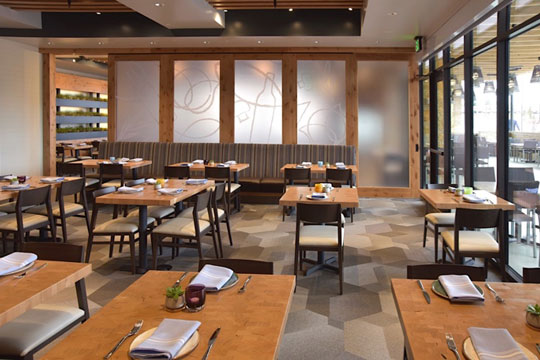Pan Asian Dining Islamabad: Appreciate Authentic Asian Meals
Pan Asian Dining Islamabad: Appreciate Authentic Asian Meals
Blog Article
Savor Genuine Asian Cuisine With a Pan-Asian Twist for a Culinary Journey
Getting started on a culinary journey via genuine Oriental cuisine, enhanced with a Pan-Asian twist, uses an one-of-a-kind possibility to check out the rich tapestry of tastes that define the area's diverse culinary customs. As you consider these enticing recipes, take into consideration the cultural stories and historic influences that form them, each bite providing a tale waiting to be found. pan asian restaurant Islamabad.

Discovering Pan-Asian Flavors
In the world of global gastronomy, Pan-Asian food sticks out for its exceptional variety and the harmonious interaction of tastes from numerous Asian cultures. This cooking strategy commemorates the abundant practices and special ingredients found throughout the continent, creating a tapestry of preferences that is both rewarding and intriguing. Key to Pan-Asian food is its capability to stabilize contrasting tastes-- wonderful, salted, spicy, and sour-- while highlighting the quality and quality of each active ingredient.
From the umami-rich soy sauce of Japan to the intense chili peppers of Thailand, Pan-Asian cuisine provides a comprehensive combination of flavors. These elements are commonly incorporated in innovative methods, boosting meals with layers of complexity. For circumstances, using great smelling herbs such as lemongrass and cilantro, usual in Vietnamese and Thai food, adds a revitalizing illumination to meals, while the unification of coconut milk delivers a velvety, abundant appearance.
The focus on fresh fruit and vegetables and aromatic flavors makes sure that each meal is not just a banquet for the taste buds however also for the detects. Pan-Asian cuisine welcomes restaurants to embark on a cooking trip, exploring the huge and differed landscapes of Asian gastronomy with every bite.
Blend Dishes to Try
While Pan-Asian cuisine is celebrated for its typical tastes, the contemporary cooking landscape is increasingly welcoming blend recipes that blend these classic components with impacts from other areas. This innovative method not only honors the rich heritage of Oriental cookeries however additionally introduces novel preference experiences that appeal to modern palates.
An archetype of such a fusion dish is the Korean-Mexican taco, where seasoned bulgogi beef is wrapped in a cozy tortilla, topped with kimchi and a hot gochujang-infused salsa. This combination marries the bold, savory flavors of Korea with the lively, fresh elements of Mexican food. In a similar way, sushi burritos have acquired appeal, amalgamating the delicate virtuosity of Japanese sushi with the passionate, hand-held benefit of a burrito, commonly including fusion active ingredients like tempura shrimp and avocado with a drizzle of wasabi mayo.
An additional notable recipe is Thai curry ramen, which infuses the creamy, aromatic seasonings of Thai curry right into the calming broth of typical Japanese ramen, producing a harmonious blend that entices the senses. These fusion recipes extend beyond plain uniqueness; they stand for a culinary dialogue between societies, encouraging exploration and technology on the planet of Pan-Asian food.
Necessary Active Ingredients and Flavors
To absolutely value Pan-Asian food, one should recognize the crucial active ingredients and seasonings that create its structure. This varied cooking style draws from an abundant tapestry of Oriental traditions, using a harmonious blend of textures and tastes.
Fragrant components are critical, with garlic, ginger, and lemongrass being common across numerous Pan-Asian recipes. These ingredients offer a great smelling base that boosts the intricacy of flavors. Flavors such as star anise, cardamom, and cinnamon introduce warmth and character, resembling impacts from regions like China and India.

Food Preparation Techniques and Tips
Understanding the art of Pan-Asian cuisine calls for experience with its distinct cooking strategies, each contributing to the vivid tapestry of flavors this culinary tradition is commemorated for. Central to these techniques is the stir-fry, a rapid cooking method that protects the dietary honesty and brilliant colors of active ingredients. Utilizing a wok, the stir-fry technique permits also warm circulation, crucial for attaining the characteristic structure and taste equilibrium of Pan-Asian recipes.
Another basic technique is steaming, specifically prevalent in Chinese food. This gentle approach keeps the all-natural flavors and nutrients of components, making it optimal for seafood and vegetables. Dumplings, a More Info cherished staple, usually gain from steaming, leading to soft, succulent textures.
Barbecuing, additionally important, imparts great smoky midsts to recipes such as Oriental bulgogi or Japanese yakitori (asian fusion restaurant). This strategy often involves marinading ingredients, enabling flavors to pass through deeply before cooking over an open fire or warm plate
Lastly, understanding the art of balancing tastes-- pleasant, sour, salty, bitter, and umami-- is critical. Correctly layering these elements can raise a dish from average to remarkable, supplying a facility and pleasing cooking experience that symbolizes the essence of Pan-Asian food.
Dining Experiences Worldwide
Around the world, Pan-Asian cuisine uses an exceptional eating experience, commemorated for its abundant tapestry of tastes and dynamic discussions. This culinary sensation has actually transcended cultural borders, recording the hearts and palates of food enthusiasts worldwide. In cosmopolitan cities like New York, London, and Sydney, Pan-Asian dining establishments work as fusions where culinary traditions from Thailand, Japan, China, and past assemble, supplying restaurants with an eclectic mix of recipes that highlight the area's diversity.
The international charm of Pan-Asian food lies in its capability to provide both authenticity and innovation. Chefs skillfully marry typical ingredients such as lemongrass, soy sauce, and miso with contemporary methods, causing recipes that are both refreshingly new and familiar. This combination permits diners to embark on a culinary journey that values heritage while embracing modernity.
Additionally, eating experiences are elevated with thoughtfully developed atmospheres that mirror the principles of Pan-Asian appearances. From minimal Japanese-inspired interiors to lively Thai-themed Website rooms, each restaurant supplies a special setting that matches the cooking offerings. As a result, patrons are not just eating a meal but partaking in a social experience, making Pan-Asian dining an absolutely worldwide phenomenon.
Final Thought
The expedition of Pan-Asian food provides a profound understanding of the elaborate interplay of tastes and culinary practices across Asia. By embracing fusion recipes such as Thai curry ramen and sushi burritos, the cooking journey not only highlights the flexibility of standard active ingredients however likewise showcases ingenious modern methods. This gastronomic adventure, enhanced by cooking methods and important my site flavors, offers a special possibility to value the multiculturalism and culinary creativity that specify Pan-Asian food on an international range.
Getting started on a cooking trip with genuine Oriental food, improved with a Pan-Asian twist, supplies an unique opportunity to check out the abundant tapestry of tastes that specify the area's varied culinary customs.In the world of global gastronomy, Pan-Asian cuisine stands out for its impressive variety and the harmonious interplay of flavors from various Eastern cultures. Key to Pan-Asian cuisine is its ability to stabilize contrasting tastes-- pleasant, salted, spicy, and sour-- while highlighting the freshness and top quality of each component.

Report this page